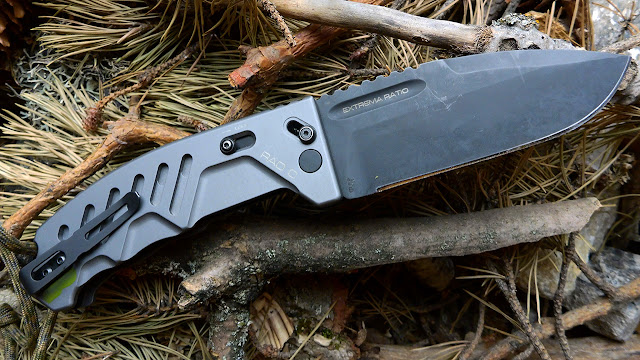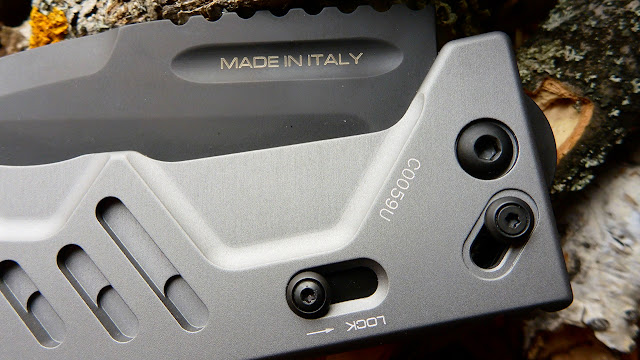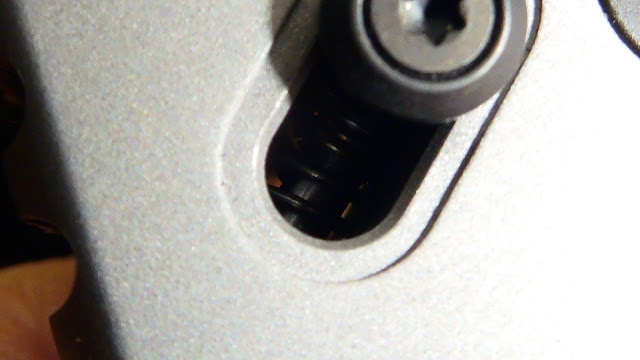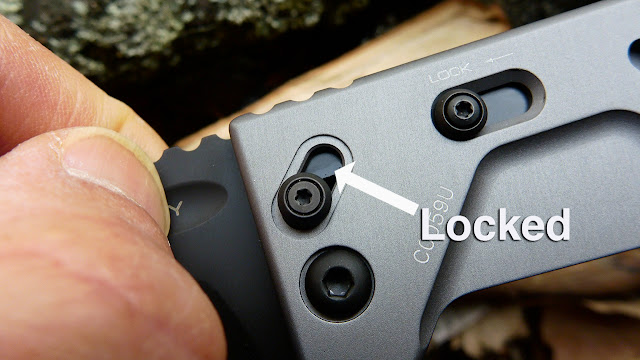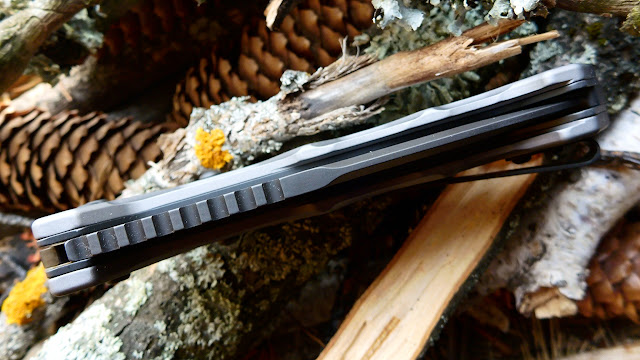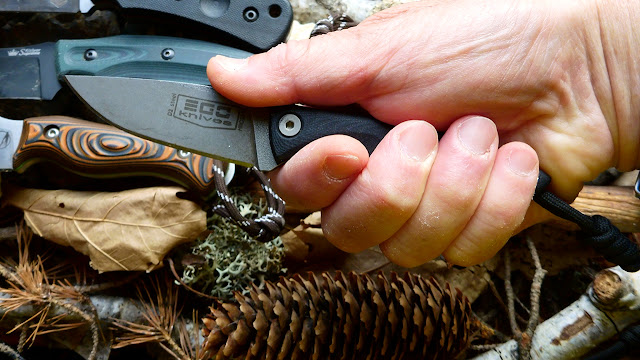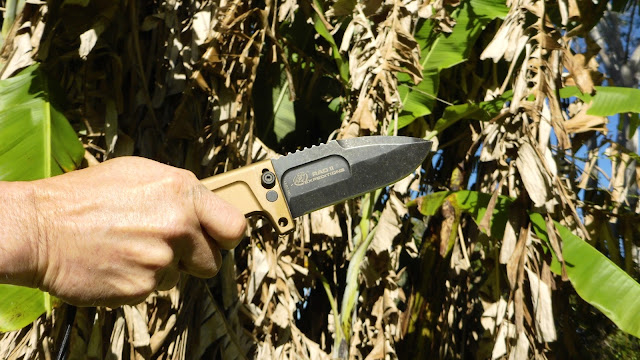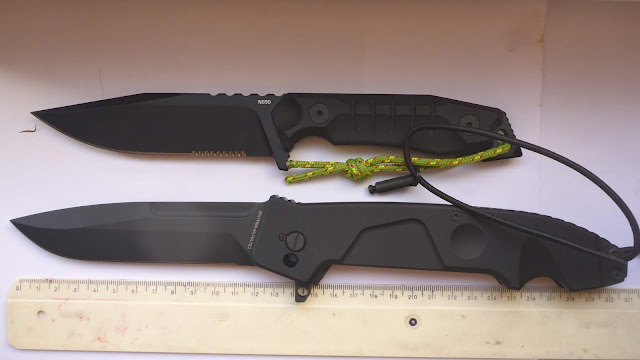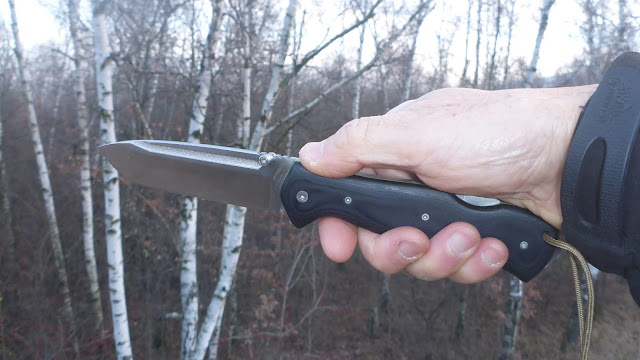Heck, I use my old boxes to transport my stuff in suitcases all over the world! Shame on me!
The Extrema Ratio RAO C comes in 2 variations. All black (but of course!) and this one shown above (Tactical Grey). I liked the sound of "Tactical Grey" and it certainly looks the part, so that's why I got this model.
There are "greys" and "greys"- seriously, there are many shades of grey (memory serves me correctly we can see about 256 scales of grey)!; and the one they have chosen for the hard anodising is very nice.
Because some greys can look "old fashioned and boring"! Nothing old fashioned or boring here, let me tell you.
The Construction
Well, IMHO the best folders have a fully enclosed back. Why is is good? The more material in contact with the two scales or liners makes for a more rigid folder and hence stronger.
It doesn't matter what that material is (G10, carbon etc.) and some manufacturer's use G10 or similar. Extrema Ratio use steel, in this case N690. The liners are made from 420HC.
The aluminium scales are milled from 6082 grade Aluminium and as mentioned hard anodized for extra corrosion and scratch proof durability. (getting a knife scratched has never worried me as I'm not really a collector of knives but a user, however as a collector, one might also be very interested in having their collectors items as resistant to scratching as can be).
The milling pattern looks very funky however, providing very good grip in what is otherwise a straight sided handle. Whilst it may look like the milling goes all the way through the scales, it doesn't.
The closed length of the Extrema Ratio RAO C is 130mm (basically 5") as measured from the arc of the blade to the glass breaker/persuader at the butt end. The maximum closed width is approx 50mm (2"). This IS a pocket friendly EDC folding knife unlike it's bigger brother/cousin/sister etc etc. whatever! (see below).
Seen side by side one soon realises the RAO Expeditions is a ginormous folding knife! Well I guess you can not have some little itty bitty knife named "Expeditions" can you ?
Here in this above image one can get a glimpse of the width profile and one can easily see that the widths of the 2 knives are not that dissimilar. THE RAO II Expeditions being about 16mm wide and the RAO C approximately 15mm wide. Unlike the RAO II Expeditions (and the other RAO's), the RAO C sports some 420HC liners and this construction probably accounts for the similar width profile.
Now it's really easy to see the ginormous size of the RAO II (the Expeditions model shown here) as compared to the new Extrema Ratio RAO C.
Now for a quick bit of "Eye Candy"
Not So Obvious (but a really great design improvement and a big PRO IMHO) let's talk about Functionality.
Notice the angled lock release bar? (see image below) It's at an angle instead of the vertical orientation of the locking bar in the RAO models. Well guess what? This makes for a much more ergonomic release of the locking mechanism because your forefinger and thumb will want to naturally pull this part towards you unlike the movement of the lock bar in the RAO II (and other RAO's) whereby the movement in directed upwards, which is not as easy IMHO. By "pulling" the locking bar towards you, you can easily keep your entire hand gripping the RAO C spine/knife body. The RAO II and other RAO models are more likely intended, once open, they are staying open, hence the capability of easily carrying these much larger folders in a sheath like a regular fixed bladed knife via the screw in safety pin.
How Does This Lock Work?
A very nice beefy spring is used as part of the locking mechanism!
As the tang, rotates into the open position, the rear curved section causes the compression of of the locking bar spring. Continued rotation to the fully open position causes the compressed lock bar to slip into the tang notch. The tang notch of the Extrema Ratio RAO C is set at an angle unlike the near vertical notch as seen in the RAO and RAO II models. Once the notch is presented to the lock bar, the bar will simply move into the notch under the energy of the compressed locking spring.
The ingenious method the this locking mechanism (and similar to the RAO II and other RAO models) is that any force attributed to the closure of the blade, will be totally resisted by the locking bar. In the case of the Extrema Ratio RAO C, that locking bar is set within both thick (2.14mm) 420 liners and of course the 6082 Al scales for added strength.
Now a sharp blow to the mechanism, as in a downward thrust of the knife to an immovable object in the RAO II and or other RAO models can cause the compression of the locking bar spring via the momentum of the actual bar causing the compression of the spring as the bar will tend to move in a vertical direction and that vertical direction can only be "up". Under some circumstances, this could cause the lock to be momentarily disengaged (only if it clears the deep notch).
Hence on those models mentioned above, it is highly recommended to use the supplied locking safety pin in order to totally negate this effect and render the knife essentially as a "fixed blade.
Now for the RAO C, the same movement the lock bar is not running in a vertical slot but an angled slot and thus will resist a movement in a vertical motion and hence not compress the locking bar spring. To further aid in safety, the Extrema Ratio RAO C sports a built in safety lock and when this is slid forwards, 2 steel plates** ( 2mm of 420 steel) slide above the locking bar, (one on either side of the bar) so any motion which might be felt by the locking bar (if subjected to severed forces) will be prevented from moving and hence the knife will stay locked open and can not close until the safety is disengaged and the locking bar withdrawn.
Conversely, the the RAO C can be locked closed by actuating the safety lock with the blade within the housing.
** Remember there is no direct force upon these plates, they are merely there to negate any effects of severe vibration because the forces are applied to the locking bar itself and the notch of the tang.
Obvious Functionality
Lanyard hole and "persuader" butt end. Nothing more to say about this other than one could possibly use this heavy set end to bust up some glass windows etc. You can also see in this above image that the RAO C can be equipped for either lefthand pock carry or right handed pocket carry (see drilled and tapped scales). The bolts are either TORX or Allen key/hex/socket heads. There is no (fine) adjustment on the main pivot bolt unlike seen in all of the RAO models. The rear Torx is a T8x60, as similar to the RAO II. All other Torx are smaller. BTW, I'm not going to list the other bolt sizes as pulling apart your new folder would surely negate any warranty offered by ER.
Excellent spine thumb gimping like as in the "older brother" 兄The design like in the RAO II and others in this "family" allow for easy maintenance of contact surfaces with lubrication. (I personally use Mountain Bike lubricants (ones designed NOT to attract dirt and mud) or silicone gun lubricants for all of my folding knives).
A very manageable sized knife
Ok so quick summary (prior to my field review- coming soon!) @BushCampingTools
Pros:
Great size for a "large folder"*** as apposed to a "ginormous folder"
Pocket carry/EDC friendly! (see caveat below).
Can be locked closed.
Very ergonomic lock release to actuate with forefinger and thumb.
Grippy scales, wet or dry.
Cleaning a freshly shot dove for dinner
Deep carry- either right or left handed.
Secure safety lock and easy to actuate.
*** Ok so what's a small folder? Like a 2 bladed SAK.
Cons:
Like ALL folders, (you can't treat with total disdain in regards to mud, dirt and sand), they are NOT maintenance free due to their many moving parts!
The scales in certain areas could have been "smoother" (underside closest to the knife tang) as in the RAO II and RAO II Expeditions, although I can see why ER did not do this as it would not allow them to make both scales and liners flush with one another. It's not a big deal.
The original (as seen in the USA at IWA 2023 pocket clip was in Ti but to be honest, I like this steel design better and Ti doesn't necessarily make for a better clip, nor does it really cut down on carry weight in a significant way. however,.........
the "deep carry" clip could be better designed because even wearing this knife on my "tactical" (and knife carry reinforced) Helikon Tex pants,
the bolts securing the clip (almost) prevent the pants material to slide all the way to the end of the clip. This would not be a problem if the knife was worn on regular jeans or any pants where the material is NOT reinforced and hence thicker.
The original model as shown at IWA 2023 had a pivot mechanism like the RAO II and was fully adjustable, unlike this current production model of the RAO C. Maybe this was cost cutting? (but not quality cutting).
It doesn't bother me really, as only more screws and bolts to loose LOL!; and these design changes are to be expected when it comes to the production models.
More EYE CANDY!
Ok so stick around for the real test in my upcoming field review where a lot more will be seen and revealed @BushCampingTools
BCT
